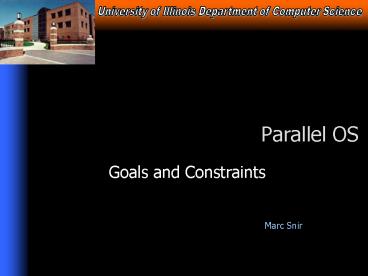Parallel OS PowerPoint PPT Presentation
1 / 14
Title: Parallel OS
1
Parallel OS
- Goals and Constraints
2
I, too can have a cartoon
3
OS
- implements virtual machine seen by application
software - higher level of abstraction than HW
- can be runtime!
- provides protection error recovery
- performs resource management
- because system goal function application
goal function
- resources are allocated on demand
- works when each app uses small fraction of total
resources - OS predicts future application needs, based on
past behavior - OS is autonomous
4
Key Questions
- Does parallel OS define right virtual machine?
- Does is apply right resource management policies?
- Does it provide required protection recovery?
5
Cluster OS
- Node OS is full-fledged Unix system
- Global OS is set of cluster services built atop
Unix networking APIs
6
Problems
- Very limited set of global services, with low
performance, since atop networking APIs - Local resource management decisions are often
wrong, since based on local information and on
irrelevant time sharing model - No distinction between internal and external
allocation - Resource management is too fine grain
- E.g. mem management, global malloc (same
address everywhere), dynamic gang scheduling
(comm variance) - IO
- node asynchronous IO
- global blocking IO, for long delay events
(msecs) - global swap, for very long delay events (secs)
7
Desired Structure
- Each parallel application is provided with a
dedicated virtual parallel machine - E.g. space partition, for a long time block
- changes in VPM resources are rare and are
negotiated - Hw provides protection across VPMs
- resource management inside VPM done by runtime
- thread scheduler, memory manager, IO
8
Implementation
- OS proxy is local representative of global OS
- attaches/detaches resources to/from VPM
- handles exceptions
- does not implement local policies
- does not manage VPM resources
9
Global runtime abstractions
- Collective service invocations
- collective IO, collective malloc,
- Scalable, associative individual invocations
- call logically made to global server
- actually serviced by local proxy or regional
proxy - associative service throughput scales with
number of servers - e.g. global queue
- also gains locality
10
Where does OS run?
- Local proxy must run on local node
- may mostly use semi-dedicated resources?
(separate CPU in large SMP node) - Global OS logic may run at dedicated server nodes
or be distributed all across, or both - answer not obvious with large SMP nodes and
modern interconnects
11
Shared Memory OS is it different?
- Many differences of detail same global
structure - need local proxies for performance and fault
isolation - need recoverable/transactional communication
protocol between proxies (message passing?) - may have more logical/flexible definition of
node - VPM has global shared memory, protected by hw
from other VPMs, and managed by runtime
12
Why ideal OS will not come from commercial
system vendors?
- Weaker requirement for strong coupling across
nodes in most commercial environments - Desire to avoid high-end unique technology
- Strong reluctance to revisit established
boundaries (OS/runtime/compiler/) - which are also organizational boundaries
- Possible commodization of OS
- all action is in the middleware
- Cost of testing, even for minute changes
- Risk avoidance and lack of expertise
13
Why ideal OS may come from commercial vendors
- Needs of large subsystems
- DB, web servers
- Needs of new hw architectures
- Security problems in large, monolithic kernels
14
Possible path
- Revisit Sandia design, in light of larger SMP
nodes - heavy server node with general purpose OS
- light compute node with simple exec, managing
single user process - derived from real-time OS? from Linux?
- Develop global OS functions incrementally
- Ensure that future architectures provide right hw
protection mechanisms to enable user runtime VPM
management - take advantage of hw support of hypervisor?

